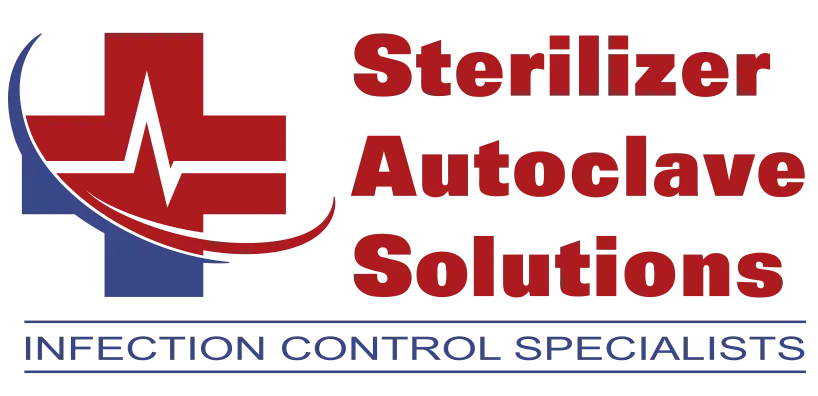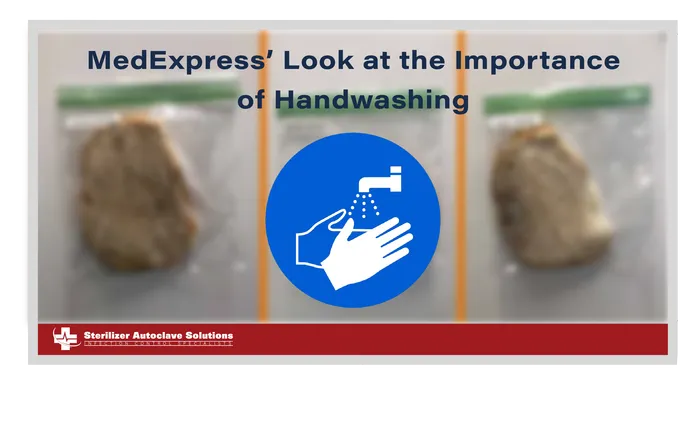MedExpress’ Investigation Into the Importance of Handwashing
In August 2024, MedExpress sought to answer an important question that, due to the events of the past 4 years, is now more prevalent than ever… Are your hands really as clean as you say they are? If you’ve read anything from us we’ve definitely hammered the importance of hand hygiene many times. For good reason, of course, because hand hygiene is severely important. Think of the many things your hands will come into contact with day-to-day. There’s absolutely no way that anyone believes that washing your hands isn’t good practice. Except maybe that one medical facility we covered that opted to study whether hand hygiene was even needed before major medical operations…
Nevertheless, we always do our best to keep you informed and to help you better understand why points like this are so important… This article is no different. In this article, we’d like to take a look at an experiment performed that helps break down the importance of hand hygiene. And they do it in a way that’s easily digestible for anyone; by taking it back to high school science.
The Info
In this recent experiment, MedExpress starts by going over the numbers when it comes to daily bacteria. They start by saying that from the time you wake up to the time you go to sleep, your hands come into contact with many different surfaces and objects. Which is absolutely true. But it’s not something we think about that much. Your bed, countertops, doorknobs, appliances, even your phone. At this point, you haven’t even left the house yet, so just imagine what else you come into contact with in a day. All along the way, you’re picking up countless bacteria on your hands. MedExpress reports that for every centimeter of skin, there are about 1,500 bacteria.
So that already puts your bacteria count into the millions if you account everywhere else. And you’re spreading that to anything or anyone else you touch too. So do everyone and everything a favor; wash your hands. Seriously. Studies from the CDC have concluded that washing your hands can prevent one in five respiratory illnesses like the cold and flu. Which during those times of the year is definitely something you want to avoid. They also confirm that handwashing in itself can lead to less use of antibiotics, which means less antibiotic-resistant bacteria, aka superbugs. Which we’ve gone in-depth on and you can find the article on our site here.
But with all of this info in their hands, MedExpress decided to provide a visual aid into the dangers of improper hand hygiene in a way that’s accessible for all ages.
The Experiment
This experiment is designed to give a visual indicator as to just how much bacteria we carry on our unwashed hands everyday. And it all starts with bread. If you’re partaking in this experiment, you’ll probably want to do what MedExpress’ team did and use bakery fresh bread with no preservatives. Because it’s reported that the preservatives would slow down mold formation and defeat the point of the experiment.
Through this experiment, they aimed to visualize the bacteria on your hands via the growth of mold on bread. To do this, they used 3 pieces of fresh bread, one control variable, one that’s been touched by an unwashed hand, and one that’s been touched by a clean, washed hand.
Performing the Test
When it comes to the experiment itself, we opted to describe it in the way it was presented by the team at MedExpress. They started with their 3 pieces of bread, 3 labeled sandwich bags, and a pair of gloves to handle the control variable. Using the gloves, they put the control piece in its bag, untainted by an unwashed hand. Then the piece of bread that’s only been handled by clean, washed hands. Once the bread was in their bags, the next thing to do was play the waiting game. The experiment ran for 10 days, checking in every few days with progress reports. And here’s what they observed.
Days 3-5
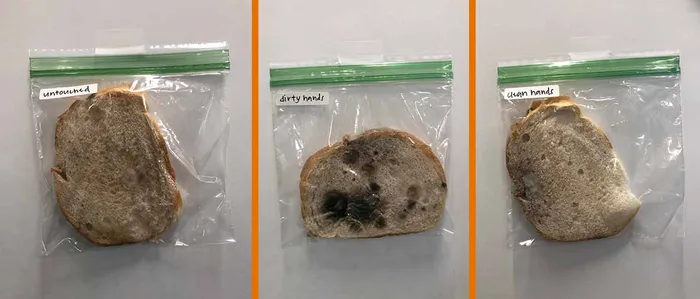
With the picture shown, no changes were observed on the control piece from days 3 to 5. But there was mold growth on both the clean and dirty bread pieces. The bread that was handled with clean hands had some initial growth, but not nearly as much as the piece handled with unwashed hands.
Day 7 and Day 10
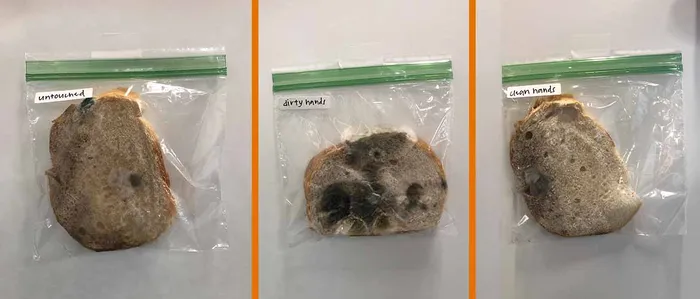
Day 7 had shown even more significant growth for the middle variable handled by unwashed hands. In fact, it’s even more glaring of a difference than the other pieces from clean and untouched. They say in their article that the experiment already garnered significant results after the full week that the test could stop there. But the team decided to continue to another 3 days and checked in on it and found the following;
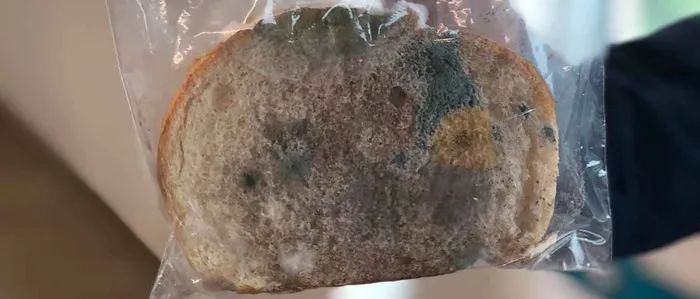
With mold clinging onto the plastic material of the bag, the piece of bread touched by unwashed hands was covered. The other pieces still had shown slightly more growth, even the control piece had grown more mold. But that was most likely due to the fact that by this point, the bread was past its shelf life. However, neither compared to the practical ecosystem that had accumulated in that bag from dirty hands. This polka-dot painting of mold growth had warped the bag itself and led to ask if it had done so due to the lack of oxygen in the bag. Because once the experiment started, the bags were never opened, only observed.
What they also noted was the types of mold that could potentially be present on bread:
- Rhizopus – Gray or black, usually fuzzy. This is the most common type of bread mold.
- Penicillium – Green or light blue and white, usually fuzzy. Did you know? Blue cheese contains penicillium, but is safe to eat because it cannot produce the toxins mycotoxins and aflatoxins, which are found in dangerous molds.
- Aspergillus – Green-blue in color. This type grows fast and usually in large clumps.
- Fusarium – Brown or red, also grows very fast.
These are the 4 most common kinds that grow on bread. But they also did observe other types like yellow and black mold.
Final Thoughts – What Did It Teach Us?
First and foremost: please wash your hands. It’s more important than some people realize, and hopefully this experiment helps everyone understand that better. It’s something that people at places like MedExpress and other medical outlets stress highly. And we here at Sterilizer Autoclave Solutions also do everything in our power to ensure that everyone, customer or not, know the importance of things like sterilization, hygiene, the works. Trust us, if we didn’t care, it wouldn’t be in our name.
Whether it’s flu season or the busy routines of daily life, it’s essential to prioritize frequent hand-washing. Hand hygiene is particularly crucial during critical moments such as before eating, after using the restroom, or following coughing or sneezing. MedExpress even provided a short list of ways to better your hand hygiene strategy:
- Wet your hands with clean, running water and apply soap.
- Rub hands together with soap to produce a lather.
- Scrub all the surfaces of your hands and wrists. Don’t forget your palms, back of hands, between your fingers, and under your nails. Not sure how long to wash for? Hum the “Happy Birthday” song twice.
- Rinse soap away with clean running water.
- Dry hands using a one-time use paper towel.
Along with MedExpress’ versatile strategy, SAS is here to help better the hand hygiene movement as well. So if you have any questions about hygiene and sterilization practices, check out the news tab on our website. It’s full of resources that cover a wide variety of topics that span the world of infection control. Or if you have questions, our Free Tech Support is available to anyone, customer or not, for free at any time. You can call us at 704-966-1650 Option 3. We also have various programs accessible to anyone using the links below.
As always if you have any questions about this process or anything else please feel free to contact us and take advantage of our “FREE TECH SUPPORT.”
We also offer FREE VIRTUAL TECH SUPPORT to “See and Talk” with a “Real Time Live Technician” for any problems you may be in need of help with.
You can also use our “FREE MAINTENANCE PROGRAM”. Take the guesswork and worrying about what unit is due for maintenance and which maintenance cycle it is time for. We will keep track of all your autoclaves and let you know when it’s time for anything.
